We are keeping with our IELTS Academic Writing Task 1 theme today, you'll get some go-to structures for grammar and vocabulary to make your writing a bit easier.
But before we get started, you should know that the IELTS writing test marking criteria are divided into four parts, each worth 25% of your score.
• Task Achievement
• Coherence and Cohesion
• Lexical Resource
• Grammatical Range and Accuracy
To see detailed information on the marking criteria see my 5-step strategy post.
This blog will give you my go-to or useful handy grammatical structures and vocabulary to help you as you write your IELTS academic writing task 1.
Accuracy and Range
It is important to note that you will be evaluated on two key factors in your writing:
1. Your ability to produce grammatically accurate sentences.
2. Your ability to use a wide range of grammar structures.
Unfortunately, grammar tends to be the area where many students struggle the most and it can have a big impact on scores.
Your grammatical accuracy
When it comes to the accuracy of grammar, examiners look for error-free sentences. Therefore, it is important to ensure that each sentence doesn't have any errors. Even small mistakes such as misplaced articles or plurals can count against you.
So it is super crucial to check your work after writing. Leave yourself a few minutes at the end to review your work. I recommend 3 to 4 minutes to double-check your writing. Simple errors that can be corrected with a quick check can significantly impact your score in this area.
Your range of grammar
A good answer will use a variety of appropriate structures and tenses to show a range of grammar. But please do not force complex sentences or tenses into your answers. This can make your writing seem unnatural and result in errors. Instead, aim to use complex sentences such as conditional and relative clauses that flow naturally within the context of your writing.
Certain grammar structures will help boost your score in Writing Task 1 when writing about charts, such as pie charts, line graphs, and bar charts. I have given you some structures to help below.
Remember that this advice does not apply to process diagrams, which I walk you through in this post.
How to describe trends
In IELTS academic writing task 1, you could be asked to describe trends. You may see this in a line graph, bar chart, or comparing multiple charts.
There are two main grammatical structures you can use to describe trends.
1. There + be + adjective + noun + in + noun phrase.
Example:
There was a gradual rise in the price of oil.
There has been a sharp drop in the price of oil.
Some adjectives you can use:
• considerable
• dramatic
• gradual
• moderate
• modest
• rapid
• sharp
• significant
• slight
• steep
• steady
Some nouns to help you:
• decline
• decrease
• dip
• drop
• fall
• fluctuation
• growth
• increase
• peak
• rise
• slump
• variation
2. Noun phrase + verb + adverb
Example:
The price of oil rose gradually.
The price of oil has risen dramatically.
A few verbs you can consider:
• climb
• decline
• decrease
• drop
• fall
• go down
• grow
• increase
• jump
• plummet
• plunge
• rise
• rocket
Some adverbs to help:
• considerably
• dramatically
• gradually
• moderately
• modestly
• rapidly
• sharply
• significantly
• slightly
• slowly
• steadily
• steeply
What to say when you have increases and decreases
When describing a chart in IELTS academic writing task 1, you’ll likely need to describe increases and decreases.
Here are 3 ways to describe them:
1. Noun phrase + verb + adverb.
Example:
The price of property fell sharply.
The percentage of homes dropped dramatically.
2. There + be + noun + in + noun phrase.
Example:
There was a fall in literacy levels.
There has been an increase in the cost of coffee.
3. Using fractions
Example:
The price of oil halved in less than a year.
The price of oil has halved since July.
By July, the price of oil had halved.
How to make comparisons
You may find it necessary to compare data sources, groups, and times.
To help you make the comparisons look at these five grammatical structures.
1. More/ few/ less + noun + than
Example:
Overall, more people preferred public transport than taxis.
2. Noun + more/ less + adjective of more than one syllable + than
Example:
Taxis were more popular than public transport.
3. of one syllable -er
Example: A higher number of people preferred public transport to taxis.
4. of one syllable -est
Example: The highest percentage of commuters preferred taxis.
5. The most/ least + adjective of more than one syllable.
Example: The least popular mode of transport was buses.
Let’s sum it up -but how you ask?
As you know, the IELTS academic writing task 1 is a task that requires you to summarize the information presented in a graph. Your overview paragraph should be a concise summary of the main features of the graph in two or three sentences. (Need help writing an overview paragraph? Read this.)
To help you write this, here are some short phrases you can use:
• To summarize, the most noticeable change is….
• Overall, it is clear….
• Overall, the majority/minority….
• In summary, the most prominent trend is….
Please avoid using the phrase 'to conclude' as it is only used for discursive essays. Think writing task 2!
Which tense?
Using the appropriate tenses in IELTS academic writing task 1 is crucial to score well. To determine which tense to use, look at the graph's title and the information on both axes to establish the time frame used.
Examples:
• If the time is one point in the past, for example, September 1974, then you should use the past tense.
• If it has projections for the future, for example, 2050, you need to use future tenses.
• If there is no time, you’ll use the present simple.
You may also need to use different tenses depending on the information presented in the graph. This is not an exhaustive list of tenses but being familiar with these English tenses will increase your chances of achieving your desired IELTS score.
1. Present Perfect:
Typically, you’ll use present perfect to talk about an action that happened at an unspecified time before now. The exact period is not important.
In WT1, you use this tense to talk about changes in data that have happened over a period of time.
Example: The price of oil has risen by $12 a barrel every month since April.
2. Present Perfect Continuous
This is the tense to show something started in the past and has continued up until now.
Example: Oil prices have been increasing since February.
3. Future Perfect
You use future perfect to state that something will be finished at a particular time in the future. Often you'll use ‘by’ or ‘in’.
Example: The price of oil will have reached $250 a barrel by 2025.
4. Past Simple
You’ll use this tense to talk about an action that started in the past and finished at a specific time in the past.
Example: The price of oil rose from $150 in February 2022 to $200 in February 2024.
All those numbers: approximations, percentages, and fractions
In many of the IELTS academic writing task 1 questions, you need to show that you understand percentages. This is a great opportunity to express percentages differently and increase your score.
To vary your language, you can express them as fractions or proportions. It's important to remember that you should try to vary your language as much as possible to score high in the ‘lexical resource’ criteria.
You can also consider using approximations. For instance, 49% can be expressed as “nearly a half” or 51% as “just over a half”.
Check out these expressions that can be used to express percentages:
Fractions
72%- nearly three quarters
52%- just over a half
48%- just under a half
31%- nearly a third
2%- a tiny fraction
50%- exactly a half
26%- roughly one quarter
49%- around a half
24%- almost a quarter
76%- approximately three quarters
Proportions
73%- a large proportion
71%- a significant majority
12% a small minority
2%- an insignificant minority
Now you have your "go-to" grammatical and vocabulary structures to help you get on with your writing. I hope you find this very practical post useful for your writing. It’s pragmatic but will give you some easy “go-to” structures for your writing. It's nothing sexy, but this is not a creative writing exam you’re taking after all.
Good luck! Feel free to drop me a comment to let me know how you are getting on.

